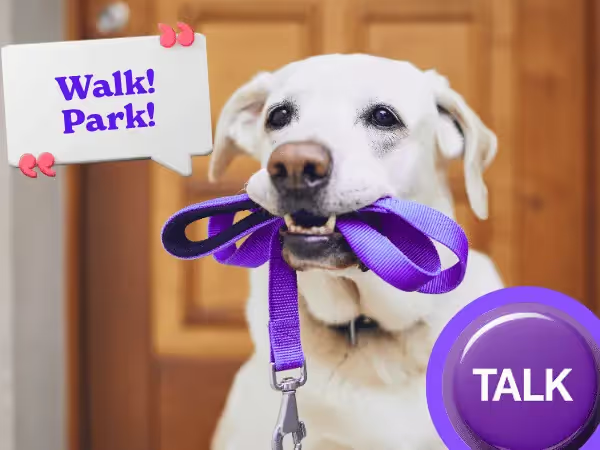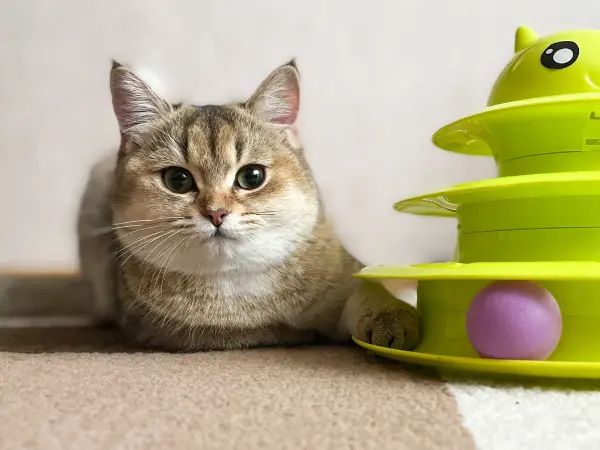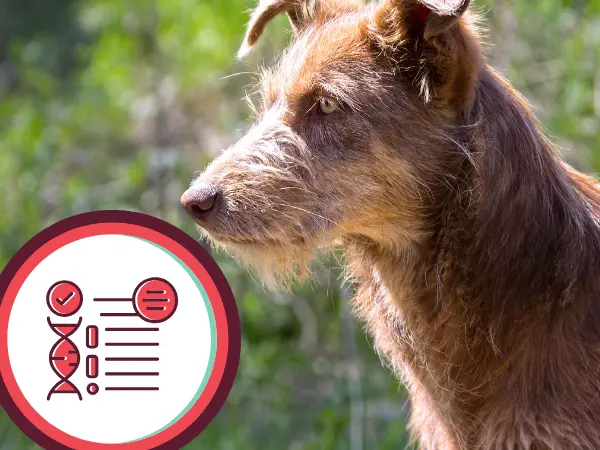Dogs understand and respond to a lot of what we say. But what if we could understand them just as clearly—not just through intuition or body language—but through actual words? What if they could clearly tell us what they need or how they feel?
This is where the social media craze, talk buttons for dogs, comes in. In this Sploot Vets guide, we discuss how to teach a dog to talk with talk buttons, how it works, and where to get talk buttons for your dog!
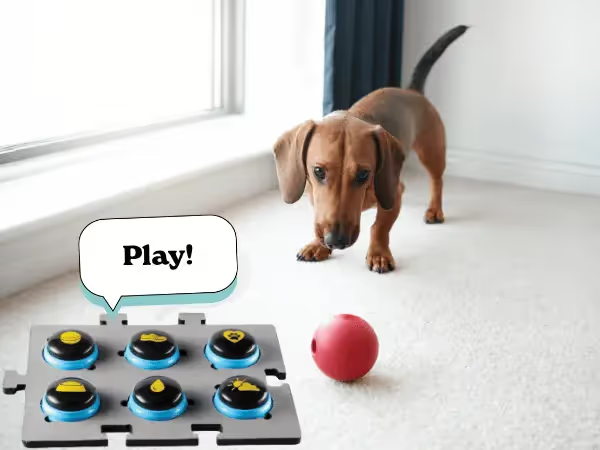
I. Can You Teach A Dog To Talk?
Yes, you can. With the right tools and consistency, you can teach your dog to communicate using talk buttons, and it might be easier than you think because dogs have a great vocabulary and innate communication skills.
What Is The Vocabulary Of A Dog?
Dogs are highly intelligent, and they can understand certain words. According to canine researcher Dr. Stanley Coren of the University of British Columbia, the average dog can learn around 165 words and signals. Even more impressively, “super dogs” (i.e., those in the top 20 percent for intelligence) can learn up to 250 words.
How Dogs Communicate [Body Language & Vocalizations]
Dogs express themselves through vocalizations, barking, dog body language, and even subtle facial expressions. You probably already recognize when they’re hungry, excited, or need a walk. They are already communicating, not just with words (yet).
II. What Are Talk Buttons for Dogs?
Talk buttons for dogs are recordable or pre-recorded sound buttons that allow dogs to communicate by pressing the buttons with their paw or nose. Each button is assigned a specific word or phrase. Over time, dogs remember what each button is for, allowing them to intentionally and clearly communicate.
Benefits of Using Talk Buttons for Dogs
- Stronger Communication & Bonding – Talk buttons give your dog a way to express themselves clearly, which deepens trust and strengthens your bond.
- Reduced Barking – When dogs have a clearer way to communicate, it can reduce excessive barking driven by frustration or confusion.
- Mental Stimulation & Enrichment – Learning and using talk buttons challenges your dog’s brain, supporting long-term cognitive health.
How Talk Buttons for Dogs Started
Talk buttons are not a new thing. They are also known as AAC (augmentative and alternative communication) devices, originally used by non-verbal children.
Christina Hunger, a speech-language pathologist, popularized using AAC devices on dogs when she tried to use talk buttons with her dog, Stella, in 2018. The results became viral. Christina is also the founder of Hunger for Words, where she shares her system with other pet parents.
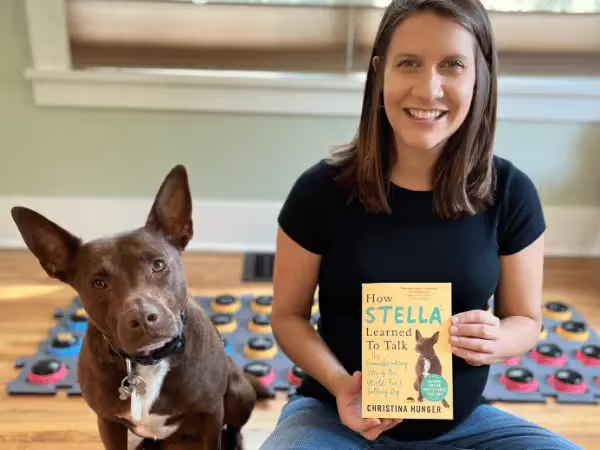
III. How to Teach a Dog to Talk with Buttons
Looking to teach your dog to talk with buttons? Follow these steps:
1. Set Up the First Talk Buttons
Using either pre-recorded or recordable talk buttons for dogs, start with words that your dog already knows and responds to, such as: Outside, Play, Walk, Food, Treats, and Water.
Use stickers, decals, or a permanent marker to place simple symbols on the buttons. This helps your dog remember which is which. You can use a mat to neatly arrange the buttons on the floor; this also helps prevent accidental kicking or stepping on the buttons.
2. Model the Usage of the Talk Buttons Consistently
Every time you're about to do an action (e.g., go outside), press the button to form an association. Here are some examples:
- Press the button for “Outside” → open the door.
- Press the button for “Food” → give them their scheduled meals.
- Press the button for “Walk” → take your dog out for a walk.
Use the button every single time the action happens. Repetition and routine help your dog make the connection.
3. Encourage Paw Pressing & Use Positive Reinforcement
Gently guide your dog’s paw to the button before the action, or reward them when they show interest. When your dog presses the button (even by accident at first), immediately respond with the action (when feasible) and lots of praise.
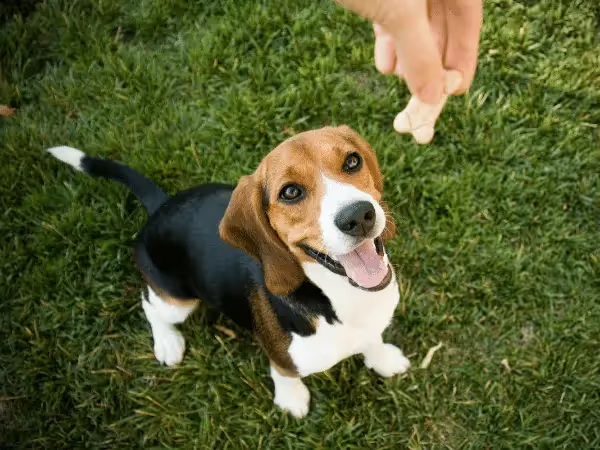
4. Setting Boundaries
If your dog keeps pressing the button for “food,” that doesn’t mean you need to feed them outside of their regular schedule. Stay calm and consistent. You can gently respond by saying something like, “That’s for later.”
The same applies to other requests that aren’t feasible, like “walk” during a rainstorm or “play” when it’s bedtime.
5. Add More Buttons Slowly
Once your dog consistently uses the first set of words, you can introduce other words and repeat these steps. After the essentials, you can build up their dog’s talk button vocabulary for the following:
- Time-related statements – later, wait, now
- Emotions – sorry, happy, scared, sick, mad, love you
- Specific toys or items – ball, duck, blanket, crate
- Names – the dog’s own name (to refer to themselves), your name (to call you), people in the house, other pets, “stranger”
- Locations in the house – couch, bed, kitchen, bathroom
- Places and routines – park, beach, pool, vet
Note: We recommend grouping similar buttons together as your dog’s vocabulary grows. This leverages “spatial memory”, your dog’s ability to remember the location of objects and their relationships in space, which prevents confusion.
IV. 3 Best Talk Buttons for Dogs
Talk buttons for dogs are available both online and in some pet stores. Popular options include the following:
- Hunger for Words – Developed by Christina Hunger herself, Hunger for Words offers durable talk buttons with both pre-recorded and recordable options. They also offer bundles and training guides for pet parents.
- FluentPet – They offer recordable, compact talk buttons for dogs and a customizable hex-tile system. They also provide courses on how to train your dog to use talk buttons.
- Amazon, Chewy, & Etsy – On these platforms, you may find talk buttons from Hunger for Words and FluentPet, along with other generic options.
Note: When buying talk buttons for dogs, always check the reviews for clarity, authenticity, and durability. You can also opt for ones with symbols, stickers, or decals to help your dog remember the buttons more easily. Certain colors may also be helpful, as long as they are colors that are visible to dogs (i.e., blue and yellow)
Final Thoughts & Dog Talk Buttons in Action
With patience and consistency, you can use dog talk buttons to interact with your dog in a mutually fun and fulfilling way. For more inspiration, here are some videos of dogs using talk buttons:
In this video by Good Morning America, Christina Hunger talks about how her dog, Stella, uses talk buttons:
In this next video by Windy City LIVE, Alexis Devine shows us how her dog, Bunny, communicates using talk buttons:
Sploot Vets: Your All-in-One Vet for Canine Health & Wellbeing
Whether your dog is learning to talk with buttons or already has a lot to say through body language and behavior, we’re here to help you understand them better and provide them with the top-tier care they deserve.
Sploot Veterinary Care provides all-in-one vet care to support your dog’s overall health and well-being. Whether you need help with canine health issues, behavioral challenges, and so on, we’re here for you.
We offer primary care, urgent care, and emergency vet services, all under one woof™! We also offer unparalleled availability, 365 days a year, with extended vet clinic hours so we can be there for you when you need us most.
Visit one of our modern vet clinics in Chicago, Colorado Springs, and Denver! Easily book an appointment online or through the Sploot Vets pet care app!


